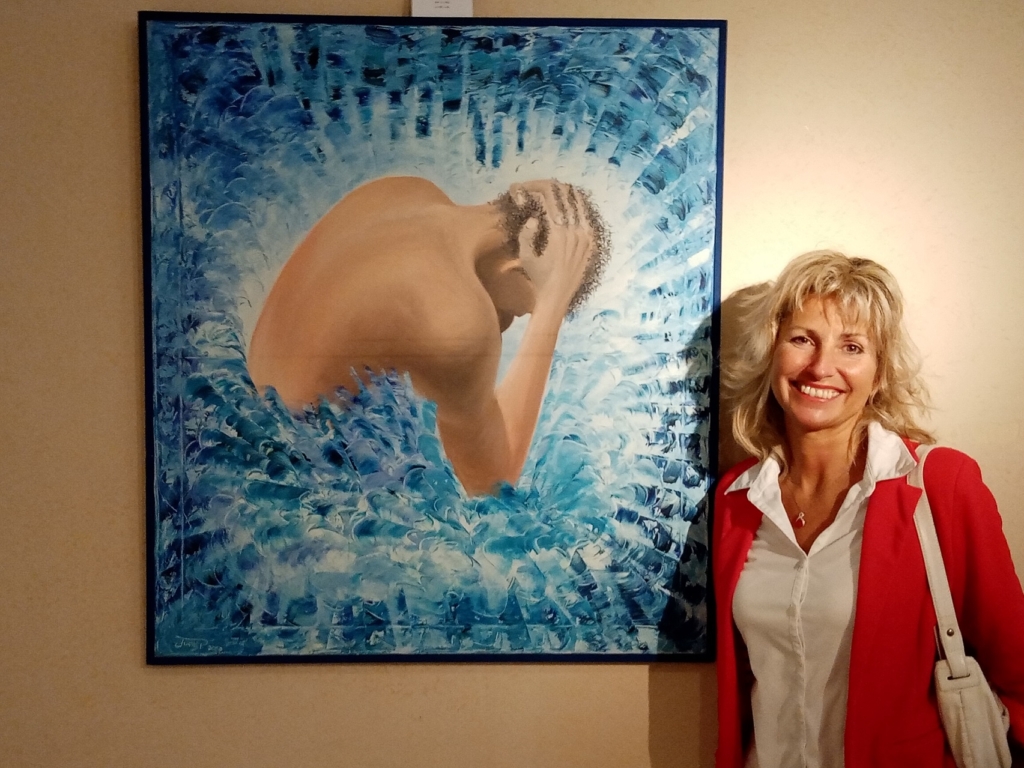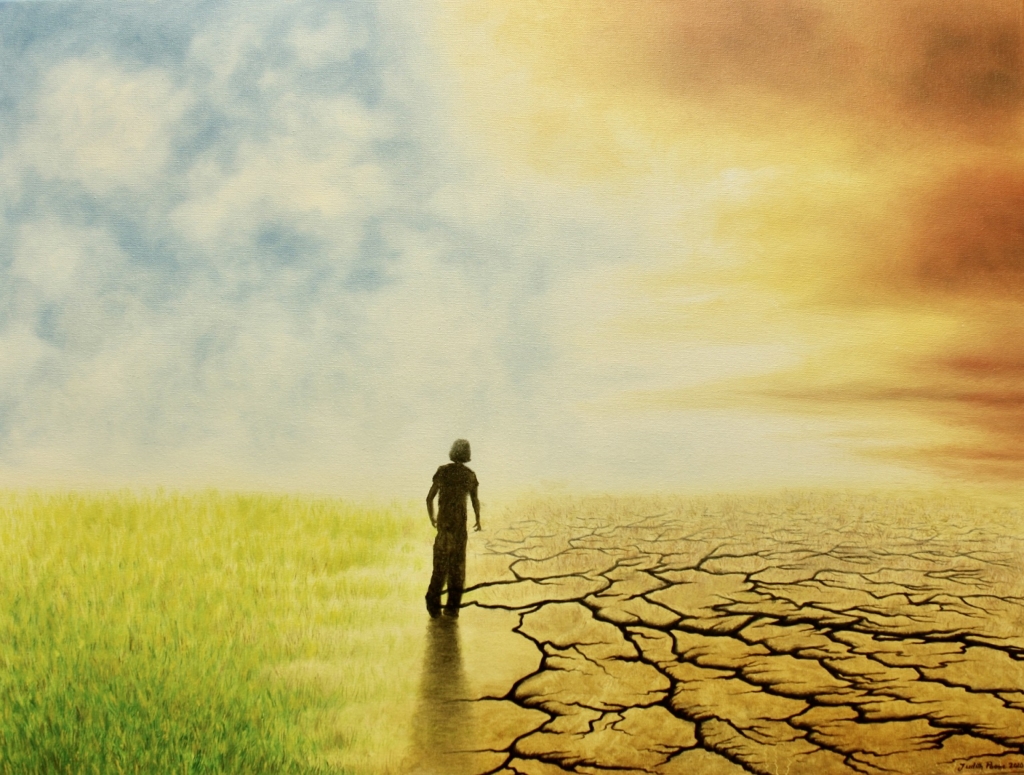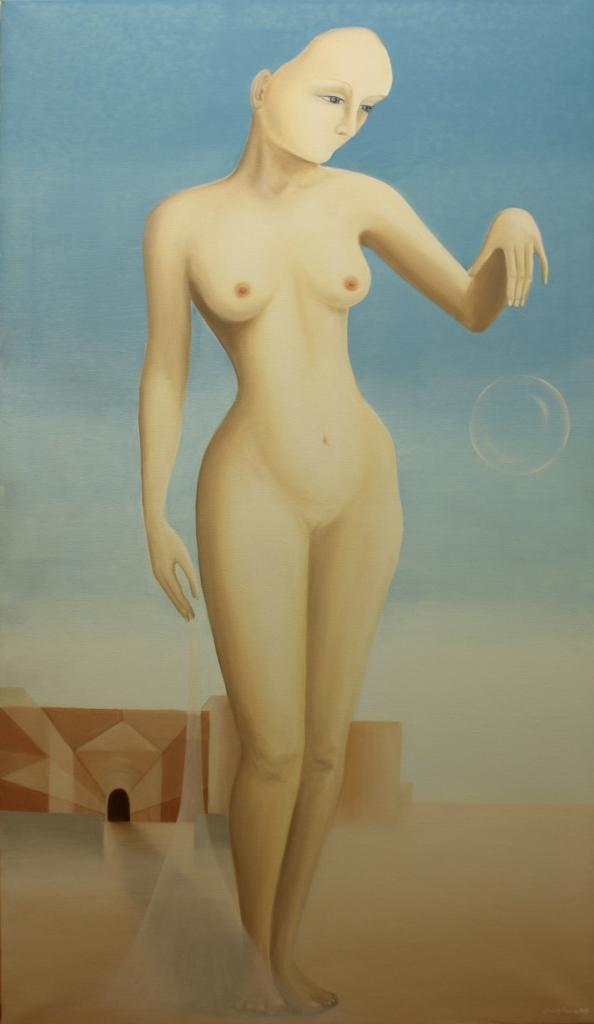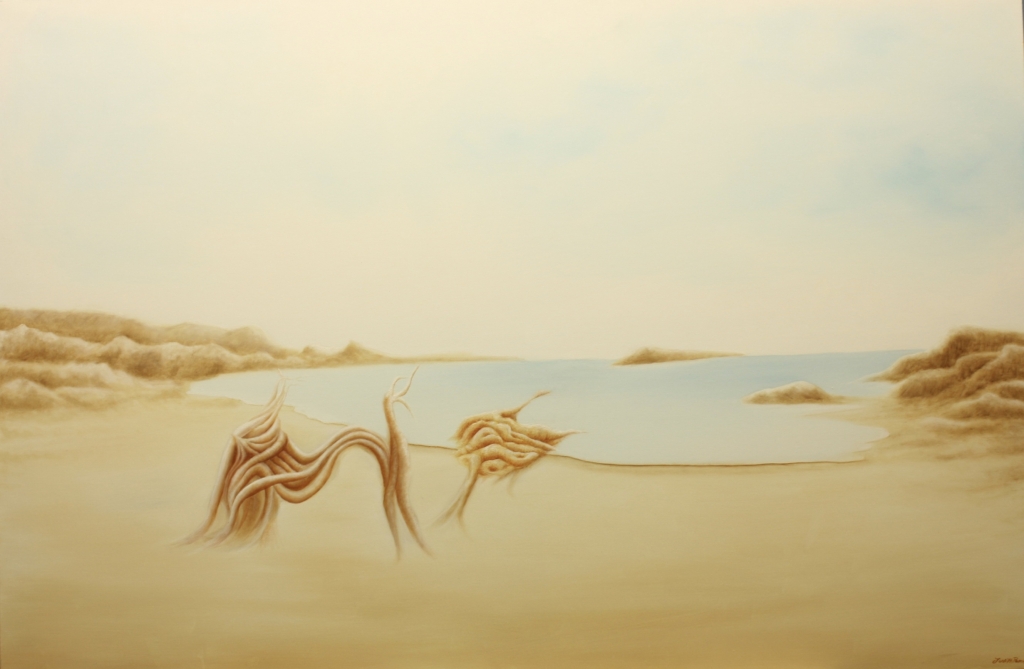di Marta Lock

Dinamica, vivace, travolgente con la sua solarità e comunicatività, l’artista Judith Paone mostra fin da bambina una forte predilezione verso l’arte, tant’è che decide di intraprendere un percorso scolastico conforme a quella sua tendenza; consegue infatti il diploma di Maestra d’Arte a cui segue quello di maturità in Maestra d’Arte Applicata. Da quel momento in poi la sua vita ruota costantemente intorno alla creatività e all’insegnamento di ciò che ha appreso nei suoi studi: infatti ha tenuto corsi di arteterapia finalizzati all’inserimento degli allievi nel mondo del lavoro, corsi di disegno, acrilico, pappmaschee, creta, per adulti e bambini, ha realizzato un grande murales del Teatro Verdi di Bolzano, ha gestito una galleria d’arte insieme a dei soci e ha organizzato mostre ed eventi d’arte. Dunque l’esuberanza caratteriale non poteva non ripercuotersi anche nell’approccio alla vita professionale conducendola a mettere in risalto l’arte per farla conoscere a un pubblico più ampio possibile, per indurre sempre più persone a sentirsene coinvolte, tanto quanto lo è sempre stata lei e per far sì che l’espressione creativa non si limiti a essere solo un passatempo bensì possa trasformarsi in una professione. Questa la sua missione che continua tutt’oggi in collaborazione con il Club Arcimboldo, associazione di Bolzano che ha come obiettivo quello di promuovere l’arte e la cultura in tutte le sue forme, dalla pittura alla scultura, dal balletto alla musica, dalla fotografia al teatro. Per quanto riguarda invece la sua personalità dinamica e vivace, che trova realizzazione nell’impegno costante nella promozione dell’arte, sembra avere un risvolto completamente opposto, eppure fortemente complementare, nelle sue opere pittoriche perché lì invece Judith Paone svela un animo introspettivo, meditativo, forse perché nel momento in cui affronta la tela riesce a placare quel suo eclettismo e a porsi in posizione di ascolto della propria interiorità ma anche delle energie sottili e silenziose che costituiscono il mondo che la circonda, spingendola a interpretarne l’inspiegabile, il profondo, ciò che in superficie non emerge. Il suo stile pittorico è Surrealista Metafisico, laddove però il Surrealismo non è inquietante, disturbante o legato al mondo degli incubi e delle angosce piuttosto va a esplorare il mistero che avvolge l’uomo contemporaneo, quel misto di incertezza e di consapevolezza della facoltà di scelta che anziché costituire un punto di forza, spesso si trasforma in incapacità di uscire da un’immobilità esistenziale che lo inchioda proprio all’interno di quella possibilità di decidere. Nella tela La scelta

infatti l’uomo rappresentato dalla Paone cammina su una linea divisoria tra un mondo migliore e uno arido in cui la vita non può svilupparsi, avvicinando l’opera alla tematica ambientalista per cui l’essere umano può scegliere se distruggere il pianeta oppure prendersene cura rendendolo rigoglioso e accogliente. D’altro canto però la tela è metafora della stessa esistenza umana, quell’opzione di coltivare anche la propria anima andando verso il bene, oppure compiere scelte sbagliate che possono inaridire e inasprire l’interiorità; o ancora l’opzione sta nell’approccio alla vita, quella differenza tra guardare il positivo e il bello in ogni piccola cosa, e il vedere invece il bicchiere sempre mezzo vuoto vivendo così in una perenne insoddisfazione e distopia emotiva. In Le tre età

l’artista evidenzia la spensieratezza della giovinezza, l’impulso che induce ad agire senza riflettere troppo, senza il filtro della ragione, quell’essere ancora in evoluzione formativa, descritta figurativamente da un mezzo volto, diversa dalla maturità in cui la donna che la rappresenta appare concentrata sulla parte razionale, riflettendo sulla vita e sugli eventi che si sono susseguiti, e infine la terza età quella in cui il protagonista è più evanescente, meno definito eppure avvolto da una saggezza che trapela non solo dal suo aspetto appena accennato ma anche dalla posizione che tende verso gli altri due, perché in fondo nella terza età si tende a guardare con nostalgia al passato, a ciò che si è stati, come se in qualche modo volesse guidare, insegnare tutto ciò che egli stesso ha appreso, confortare la donna suggerendole che anche le ferite e gli ostacoli sono necessari e accompagnare il giovane verso una formazione più consapevole, meno impulsiva, pur sapendo che anche l’istinto spesso indomabile fa parte di un cammino naturale. Andiamo ora a conoscere meglio l’artista attraverso questa intervista.
Judith, lei ha intrapreso fin da giovane la carriera artistica, quali difficoltà ha incontrato nel decidere di dedicare la sua vita all’arte? Dedicare la propria vita all’arte è una cosa meravigliosa, perché l’arte dona serenità, vitalità, grandi soddisfazioni, a volte anche lotte con se stessi, perché il quadro non riesce come si voleva, ma si impara anche a farsi condurre dalla creatività che ha infinite possibilità di espressioni e ci insegna che possiamo andare al di là della nostra immaginazione e delle aspettative, portandoci dove tutto è possibile senza limiti. Lasciandoci condurre dall’arte e dai colori, abbiamo la possibilità di scoprire noi stessi e la vita ci rivela gli aspetti più nascosti di noi stessi, gli stati d’animo che stiamo vivendo e ci insegna a vivere il presente. Ci insegna che entrando in sintonia con i colori e il quadro, lasciandoci condurre dal pennello, ci ritroviamo in nuove realtà; così come se ci facciamo condurre dalla vita, senza opporci sempre, scopriremo la meraviglia che ogni giorno ci regala. Le difficoltà si incontrano uscendo all’esterno in una società, dove l’arte viene considerata un hobby e non un dono importante che può contribuire al completamento della vita e lanciare messaggi fondamentali.

Quanto è complesso oggi riuscire a fare dell’espressione pittorica una vera e propria professione?
È molto difficile perché si deve disporre di denaro per potersi proporre e lanciarsi nel mondo dell’arte e non tutti se lo possono permettere. Se l’artista non è benestante è costretto a vivere nell’incertezza e nella precarietà e in tale condizione riesce difficilmente a fare progetti concreti per il futuro… Per sopravvivere in questo contesto è necessario riuscire a vendere le proprie opere e questo non è facile. Sarebbe invece molto positivo se le gallerie proponessero di esporre i quadri a prezzi contenuti, credendo nell’artista e facendo da tramite per creare rete e diffondere l’arte.
Sarebbe inoltre positivo se vi fossero altri circuiti alternativi dove gli artisti, soprattutto agli inizi del loro percorso, potessero proporsi gratuitamente dando in tal modo visibilità ai propri lavori. Anche le istituzioni pubbliche potrebbero essere di grande aiuto; ad esempio, potrebbero incaricare gli artisti di abbellire le città, le strade, le periferie, gli edifici, ecc. portando in tal modo gioia e vitalità ad ogni occhio che li guarda e dando colore alle grigie città. L’alternativa è puntare sull’insegnamento, che è comunque una strada nobile e di valore, perché permette di diffondere il proprio meraviglioso dono.

Le sue opere raccontano di un mondo surreale ma al tempo stesso accogliente perché le inquietudini dell’uomo contemporaneo sembrano essere rassicurate dagli ambienti raffigurati, qual è il messaggio che vorrebbe l’osservatore ricevesse dalle sue tele?
Vorrei portare i fruitori delle mie tele a riflettere sulla vita, sugli accadimenti, sul presente e sul futuro. Vorrei sollecitarli a osservare con occhi diversi il mondo, i sentimenti, l’interiorità, il visibile e l’invisibile; vorrei smuovere le coscienze, per arrivare a un mondo migliore.
Ha insegnato per molti anni arte ad adulti e bambini, ha organizzato mostre ed è stata socia di una galleria. Qual è stato il percorso che ha amato di più tra questi? E come mai poi ha deciso di dedicarsi solo ed esclusivamente alla sua arte?
Ogni percorso è stato una bellissima esperienza di vita e di scambio arricchente e rifarei ogni esperienza. Ora mi dedico esclusivamente all’arte perché ho tante mostre in programma e ci sono tanti temi da affrontare, l’ambiente, la pandemia, la guerra,

e tanti messaggi da lanciare. L’arte esige tanta dedizione e tempo: la cosa più preziosa che ho e che quindi devo usare con parsimonia. Se ci si dedica all’arte con amore e dedizione ogni giorno, essa ti regala tutto quello di cui hai bisogno nella vita: la salute grazie all’arteterapia, la serenità se sei sotto stress, l’equilibrio se ti senti smarrito, la purificazione se ti senti inquinato, teso, arrabbiato, la gioia perché vedi una tua creazione, la soddisfazione con l’opera finita, la positività e l`abbondanza in tutti i sensi. Ti nutre in tutte le cose e ti sarà sempre amica.
Il suo stile surrealista metafisico affascina proprio in virtù del mistero e delle atmosfere irreali ma al tempo stesso accoglienti, diverse da quelle del Surrealismo tradizionale. Quali sono i maestri del passato a cui si è ispirata o a cui si sente più vicina?
È sicuramente Salvador Dalì che ho ammirato sin da piccola. Lui mi ha insegnato i segreti della pittura, lo spirito, la profondità, le potenzialità e l’essenza -das Wesen- del colore. Come diceva lui: “Solo se tu ami l’arte, anche lei ti amerà”. E l’arte va coltivata con amore ogni giorno, come si innaffia un fiore delicato.
Ha esposto all’estero e in Italia in molte mostre collettive, ci racconta i suoi prossimi progetti? Dove potranno vedere le sue opere i lettori?
Per questo anno ho in programma ad aprile una collettiva alla Galleria d’arte Von Zeidler art Gallery di Berlino e una personale alla Piccola Galleria di Bolzano; a maggio una collettiva alla Orchideenwelt (Parco delle Orchidee), unico al mondo, a Gargazzone in provincia di Bolzano; a giugno una collettiva sul Lago di Garda, a luglio una personale all’Hotel Sheraton di Bolzano. Ad agosto una collettiva a Limone del Garda e un’altra alla Galleria Civica di Bolzano; a settembre una collettiva alla piccola Galleria di Bolzano e inoltre parteciperò alla Biennale Tour d’Europa che si svilupperà in varie città cominciando da ottobre a Parigi, a novembre a Barcellona, a dicembre a Londra e a gennaio 2023 a Venezia. Sto attendendo ancora risposte per esposizioni a Como, Roma e Venezia. Inoltre sto organizzando una mia galleria virtuale insieme alla Casa Editrice Pagine di Roma, dove verranno esposti dodici miei quadri.
JUDITH PAONE-CONTATTI
Email: paonejudith@gmail.com
Sito web: https://judithpaone.it/
Facebook: https://www.facebook.com/judith.paone
Instagram: https://www.instagram.com/paonejudith/
Marta Lock’s interviews:
Judith Paone, in balance between exuberance and introspection
Dynamic, lively, overwhelming with her sunny disposition and communicativeness, the artist Judith Paone showed a strong predilection for art even as a child, so much so that she decided to undertake a school career in line with her tendency; she obtained her diploma as a Master of Art, followed by a diploma as a Master of Applied Art. From then on, her life has constantly revolved around creativity and teaching what she has learnt in her studies: in fact, she has held art therapy courses aimed at helping her students enter the world of work, courses in drawing, acrylics, pappmaschee and clay for adults and children, created a large mural at Bolzano’s Teatro Verdi, managed an art gallery together with some of her partners and organised art exhibitions and events. This exuberance of character could not fail to have an impact on her approach to professional life and has led her to highlight art in order to make it known to the widest possible audience, to encourage more and more people to feel involved in it, as she has always been, and to ensure that creative expression is not just a pastime but can become a profession. This is her mission, which continues to this day in cooperation with the Club Arcimboldo, an association in Bolzano that aims to promote art and culture in all its forms, from painting to sculpture, from ballet to music, from photography to theatre. Her dynamic and lively personality, which finds fulfilment in her constant commitment to the promotion of art, seems to have a completely opposite, yet strongly complementary, side in her paintings, because there Judith Paone reveals an introspective, meditative soul, perhaps this is because when she tackles the canvas she is able to calm her eclecticism and place herself in a position of listening to her own interiority but also to the subtle and silent energies that make up the world around her, prompting her to interpret the inexplicable, the profound, that which does not emerge on the surface. Her painting style is Surrealist-Metaphysical, but Surrealism is not disturbing, disconcerting or linked to the world of nightmares and anguish; rather, it explores the mystery that surrounds contemporary man, that mixture of uncertainty and awareness of the faculty of choice which, instead of constituting a strong point, is often transformed into an inability to escape from an existential immobility that pins him down within that very possibility of deciding. In the painting La scelta (The Choice), the man represented by Judith Paone walks on a dividing line between a better world and an arid one in which life cannot develop, bringing the artwork closer to the environmentalist theme whereby the human being can choose whether to destroy the planet or take care of it by making it lush and welcoming. On the other hand, however, the canvas is a metaphor for human existence itself, that option of cultivating one’s own soul by going in the direction of the good, or making wrong choices that can wither and exacerbate one’s interiority; or again, the option lies in the approach to life, that difference between looking at the positive and the beautiful in every little thing, and instead seeing the glass as always half empty, thus living in perpetual dissatisfaction and emotional dystopia. In The Three Ages the artist highlights the light-heartedness of youth, the impulse that induces one to act without thinking too much, without the filter of reason, that being still in a formative evolution, figuratively described by a half-face, which differs from maturity in which the woman who represents her appears to be concentrated on the rational side, reflecting on life and the events that have taken place, and finally the third age in which the protagonist is more evanescent, less well-defined and yet enveloped in a wisdom that transpires not only from his barely visible appearance but also from the position he adopts towards the other two, because after all, in the third age there is a tendency to look back with nostalgia to the past, to what one has been, as if in some way he wanted to guide and teach all that he himself has learnt, to comfort the woman by suggesting that even wounds and obstacles are necessary and to accompany the young man towards a more conscious, less impulsive formation, althought he knows that even the often untameable instinct is part of a natural path. Let us now get to know the artist better through this interview.
Judith, you began your artistic career at a young age, what difficulties did you encounter in deciding to dedicate your life to art?
Dedicating one’s life to art is a wonderful thing, because art gives serenity, vitality, great satisfaction, sometimes even struggles with oneself, because the painting does not turn out as one wanted, but one also learns to let oneself be led by creativity which has infinite possibilities of expression and teaches us that we can go beyond our imagination and expectations, taking us to where everything is possible without limits. By letting ourselves be led by art and colours, we have the opportunity to discover ourselves and life reveals the most hidden aspects of ourselves, the moods we are experiencing and teaches us how to live in the present. It teaches us that by getting in tune with the colours and the painting, letting ourselves be led by the brush, we find ourselves in new realities; just as if we let ourselves be led by life, without always opposing it, we will discover the wonder that every day gives us. Difficulties are encountered when going outside in a society where art is considered a hobby and not an important gift that can contribute to the completion of life and send out fundamental messages.
How difficult is it today to turn painting into a real profession?
It is very difficult because you must have money to be able to porpose and enter the art world, and not everyone can afford it. If the artist is not well-off, he is forced to live in uncertainty and precariousness, and in this condition he can hardly make concrete plans for the future… To survive in this context, you need to be able to sell your artworks, and that is not easy. On the other hand, it would be very positive if galleries offered to exhibit their paintings at affordable prices, believing in the artist and acting as an intermediary to create a network and disseminate art.
It would also be a good thing if there were other alternative circuits where artists, especially at the beginning of their career, could exhibit their artworks for free, thus giving them visibility. Public institutions could also be of great help; for example, they could commission artists to beautify cities, streets, suburbs, buildings, etc., thus bringing joy and vitality to every eye that sees them and giving colour to grey cities. The alternative is to focus on teaching, which is in any case a noble and valuable path, because it allows you to spread your wonderful gift.
Your artworks tell of a world that is surreal but at the same time welcoming, because the anxieties of contemporary man seem to be reassured by the environments depicted; what message would you like the observer to receive from your canvases?
I would like to lead the viewers of my paintings to reflect on life, on events, on the present and the future. I would like to encourage them to look at the world, feelings, interiority, the visible and the invisible with different eyes; I would like to stir consciences to achieve a better world.
You have taught art to adults and children for many years, organised exhibitions and been a partner in a gallery. What was the path you loved the most among these? And why did you decide to dedicate yourself exclusively to your art?
Each path has been a wonderful experience of life and an enriching exchange, and I would repeat each experience. Now I dedicate myself exclusively to art because I have so many exhibitions planned and there are so many issues to deal with, the environment, the pandemic, war, and so many messages to send. Art requires a lot of dedication and time: the most precious thing I have and therefore I have to use it sparingly. If you devote yourself to art with love and dedication every day, it gives you everything you need in life: health through art therapy, serenity if you are under stress, balance if you feel lost, purification if you feel polluted, tense, angry, joy when you see one of your creations, satisfaction with the finished artwork, positivity and abundance in all senses. It nourishes you in all things and will always be your friend.
Your metaphysical Surrealist style fascinates precisely because of its mystery and unreal yet welcoming atmospheres, which are different from those of traditional Surrealism. Which masters from the past have inspired you or whom do you feel closest to?
Definitely Salvador Dali, whom I have admired since I was a child. He taught me the secrets of painting, the spirit, the depth, the potential and the essence -das Wesen- of colour. As he said: ‘Only if you love art, it will love you back’. And art must be cultivated with love every day, like watering a delicate flower.
You have exhibited abroad and in Italy in many group exhibitions, can you tell us about your next projects? Where can readers see your works?
This year I am planning in April a group exhibition at the Von Zeidler Art Gallery in Berlin and a personal exhibition at the Piccola Galleria in Bolzano; in May a group exhibition at the Orchideenwelt (Orchid Park), the only one of its kind in the world, in Gargazzone in the province of Bolzano; in June a group exhibition on Lake Garda, in July a personal exhibition at the Sheraton Hotel in Bolzano. In August a group exhibition in Limone del Garda and another one at the Civic Gallery of Bolzano; in September a group exhibition at the small Gallery of Bolzano and furthermore I will participate in the Biennial Tour of Europe that will take place in various cities starting in October in Paris, in November in Barcelona, in December in London and in January 2023 in Venice. I am still waiting for answers for exhibitions in Como, Rome and Venice. I am also organising my own virtual gallery together with the Pagine Publishing House of Rome, where twelve of my paintings will be exhibited.
